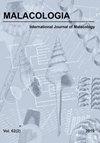南太平洋纽埃岛日本Dimya的表型特征及其系统发育和分类学关系
IF 1
4区 生物学
Q4 ZOOLOGY
引用次数: 0
摘要
摘要根据南太平洋纽埃岛的一个标本,报道了不常见的Dimya cf.japonica的表型特征,在广泛的双壳纲系统发育场景中代表了神秘的Dimyidae。主要结论是,二甲目位于鸵鸟目和梳状目之间。这得到了五个犹太孤儿院的支持。Dimyids更接近梳状动物,因为它们共有四个突触形态。本文章由计算机程序翻译,如有差异,请以英文原文为准。
Phenotypic Features of Dimya cf. Japonica (Bivalvia, Dimyidae) from Niue Island (South Pacific) with Accounts on Its Phylogeny and Taxonomic Relationships
ABSTRACT Phenotypic characters of the uncommon Dimya cf. japonica, based on a specimen from Niue Is. in the South Pacific, are reported to represent the enigmatic Dimyidae in a wide-ranging Bivalvia phylogenetic scenario. The main conclusion is that dimyids are placed between ostreoideans and pectinoideans. This is supported by five synapomorphies. Dimyids are closer to pectinoideans, in that they share four synapomorphies.
求助全文
通过发布文献求助,成功后即可免费获取论文全文。
去求助
来源期刊

Malacologia
生物-动物学
CiteScore
2.00
自引率
0.00%
发文量
15
审稿时长
3 months
期刊介绍:
Malacologia publishes papers on all groups of the Mollusca. Malacologia specializes in publishing long papers and monographic treatments. Complete data are especially appreciated. Papers must be of interest to an international readership. Papers in systematics, ecology, population ecology, genetics, molecular genetics, evolution and phylogenetic treatments are especially welcomed. Also welcomed are letters to the editor involving papers published or issues of import to science of the day.
 求助内容:
求助内容: 应助结果提醒方式:
应助结果提醒方式:


